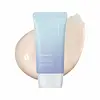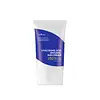What's inside
What's inside
 Key Ingredients
Key Ingredients

 Benefits
Benefits

 Concerns
Concerns

 Ingredients Side-by-side
Ingredients Side-by-side

Water
Skin ConditioningDibutyl Adipate
EmollientTitanium Dioxide
Cosmetic ColorantDiethylamino Hydroxybenzoyl Hexyl Benzoate
UV FilterPhenyl Trimethicone
Skin ConditioningOctyldodecanol
EmollientHydrogenated Polyisobutene
EmollientButylene Glycol
HumectantPropanediol
SolventGlycerin
HumectantLauryl PEG-10 Tris(Trimethylsiloxy)Silylethyl Dimethicone
EmulsifyingNiacinamide
SmoothingEthylhexyl Triazone
UV AbsorberSodium Chloride
MaskingIsododecane
EmollientAluminum Hydroxide
EmollientStearic Acid
Cleansing1,2-Hexanediol
Skin ConditioningBis-Ethylhexyloxyphenol Methoxyphenyl Triazine
Skin ConditioningTrimethylsiloxysilicate
EmollientRosa Damascena Flower Water
MaskingHydrolyzed Sodium Hyaluronate
Skin ConditioningSodium Hyaluronate
HumectantPrunus Serrulata Flower Extract
Skin ConditioningRosa Hybrid Flower Extract
Skin ConditioningSaussurea Involucrata Extract
HumectantNymphaea Alba Flower Extract
Skin ConditioningNelumbium Speciosum Flower Extract
Skin ConditioningChamomilla Recutita Flower Extract
MaskingCalendula Officinalis Extract
Skin ConditioningCamellia Japonica Flower Extract
EmollientHyaluronic Acid
HumectantHydroxypropyltrimonium Hyaluronate
Hydrolyzed Hyaluronic Acid
HumectantPotassium Hyaluronate
Skin ConditioningSodium Hyaluronate Crosspolymer
HumectantSodium Acetylated Hyaluronate
HumectantCaprylyl Methicone
Skin ConditioningPolyglyceryl-2 Isostearate
EmulsifyingDisteardimonium Hectorite
StabilisingCoco-Caprylate/Caprate
EmollientIsotridecyl Isononanoate
EmollientPolyglyceryl-6 Polyricinoleate
EmulsifyingSorbitan Isostearate
EmulsifyingCI 77492
Cosmetic ColorantPropylene Carbonate
SolventEthylhexylglycerin
Skin ConditioningTriethoxycaprylylsilane
CI 77491
Cosmetic ColorantPolyglyceryl-6 Polyhydroxystearate
EmulsifyingPolyglycerin-6
HumectantPEG-12 Dimethicone/PPG-20 Crosspolymer
PEG-10
HumectantWater, Dibutyl Adipate, Titanium Dioxide, Diethylamino Hydroxybenzoyl Hexyl Benzoate, Phenyl Trimethicone, Octyldodecanol, Hydrogenated Polyisobutene, Butylene Glycol, Propanediol, Glycerin, Lauryl PEG-10 Tris(Trimethylsiloxy)Silylethyl Dimethicone, Niacinamide, Ethylhexyl Triazone, Sodium Chloride, Isododecane, Aluminum Hydroxide, Stearic Acid, 1,2-Hexanediol, Bis-Ethylhexyloxyphenol Methoxyphenyl Triazine, Trimethylsiloxysilicate, Rosa Damascena Flower Water, Hydrolyzed Sodium Hyaluronate, Sodium Hyaluronate, Prunus Serrulata Flower Extract, Rosa Hybrid Flower Extract, Saussurea Involucrata Extract, Nymphaea Alba Flower Extract, Nelumbium Speciosum Flower Extract, Chamomilla Recutita Flower Extract, Calendula Officinalis Extract, Camellia Japonica Flower Extract, Hyaluronic Acid, Hydroxypropyltrimonium Hyaluronate, Hydrolyzed Hyaluronic Acid, Potassium Hyaluronate, Sodium Hyaluronate Crosspolymer, Sodium Acetylated Hyaluronate, Caprylyl Methicone, Polyglyceryl-2 Isostearate, Disteardimonium Hectorite, Coco-Caprylate/Caprate, Isotridecyl Isononanoate, Polyglyceryl-6 Polyricinoleate, Sorbitan Isostearate, CI 77492, Propylene Carbonate, Ethylhexylglycerin, Triethoxycaprylylsilane, CI 77491, Polyglyceryl-6 Polyhydroxystearate, Polyglycerin-6, PEG-12 Dimethicone/PPG-20 Crosspolymer, PEG-10
Water
Skin ConditioningZinc Oxide
Cosmetic ColorantButyloctyl Salicylate
Skin ConditioningPropylheptyl Caprylate
EmollientButylene Glycol
HumectantIsododecane
EmollientC15-19 Alkane
SolventDisiloxane
Skin ConditioningCetyl Diglyceryl Tris(Trimethylsiloxy)Silylethyl Dimethicone
Emulsion StabilisingCaprylyl Methicone
Skin ConditioningSodium Chloride
MaskingTriethylhexanoin
MaskingSodium Hyaluronate
HumectantGlycerin
HumectantMethyl Methacrylate Crosspolymer
Disteardimonium Hectorite
StabilisingTriethoxycaprylylsilane
Polymethylsilsesquioxane
1,2-Hexanediol
Skin ConditioningLauryl Polyglyceryl-3 Polydimethylsiloxyethyl Dimethicone
Skin ConditioningPolyglyceryl-2 Dipolyhydroxystearate
Skin ConditioningLauryl Dimethicone/Polyglycerin-3 Crosspolymer
CleansingCaprylyl Glycol
EmollientGlyceryl Caprylate
EmollientDipropylene Glycol
HumectantTocopherol
AntioxidantSodium Citrate
BufferingBetaine
HumectantInositol
HumectantPanthenol
Skin ConditioningWater, Zinc Oxide, Butyloctyl Salicylate, Propylheptyl Caprylate, Butylene Glycol, Isododecane, C15-19 Alkane, Disiloxane, Cetyl Diglyceryl Tris(Trimethylsiloxy)Silylethyl Dimethicone, Caprylyl Methicone, Sodium Chloride, Triethylhexanoin, Sodium Hyaluronate, Glycerin, Methyl Methacrylate Crosspolymer, Disteardimonium Hectorite, Triethoxycaprylylsilane, Polymethylsilsesquioxane, 1,2-Hexanediol, Lauryl Polyglyceryl-3 Polydimethylsiloxyethyl Dimethicone, Polyglyceryl-2 Dipolyhydroxystearate, Lauryl Dimethicone/Polyglycerin-3 Crosspolymer, Caprylyl Glycol, Glyceryl Caprylate, Dipropylene Glycol, Tocopherol, Sodium Citrate, Betaine, Inositol, Panthenol
 Reviews
Reviews

Ingredients Explained
These ingredients are found in both products.
Ingredients higher up in an ingredient list are typically present in a larger amount.
1,2-Hexanediol is a synthetic liquid and another multi-functional powerhouse.
It is a:
- Humectant, drawing moisture into the skin
- Emollient, helping to soften skin
- Solvent, dispersing and stabilizing formulas
- Preservative booster, enhancing the antimicrobial activity of other preservatives
Butylene Glycol (or BG) is used within cosmetic products for a few different reasons:
Overall, Butylene Glycol is a safe and well-rounded ingredient that works well with other ingredients.
Though this ingredient works well with most skin types, some people with sensitive skin may experience a reaction such as allergic rashes, closed comedones, or itchiness.
Learn more about Butylene GlycolCaprylyl Methicone is a type of silicone.
It helps soften and soothe the skin by creating a thin film on top. This film helps trap moisture, keeping your skin hydrated.
Disteardimonium Hectorite comes from the clay mineral named hectorite. It is used to add thickness to a product.
It can also help stabilize a product by helping to disperse other ingredients.
Hectorite is a rare, white clay mineral.
Learn more about Disteardimonium HectoriteGlycerin is already naturally found in your skin. It helps moisturize and protect your skin.
A study from 2016 found glycerin to be more effective as a humectant than AHAs and hyaluronic acid.
As a humectant, it helps the skin stay hydrated by pulling moisture to your skin. The low molecular weight of glycerin allows it to pull moisture into the deeper layers of your skin.
Hydrated skin improves your skin barrier; Your skin barrier helps protect against irritants and bacteria.
Glycerin has also been found to have antimicrobial and antiviral properties. Due to these properties, glycerin is often used in wound and burn treatments.
In cosmetics, glycerin is usually derived from plants such as soybean or palm. However, it can also be sourced from animals, such as tallow or animal fat.
This ingredient is organic, colorless, odorless, and non-toxic.
Glycerin is the name for this ingredient in American English. British English uses Glycerol/Glycerine.
Learn more about GlycerinIsododecane is a fragrance, emollient, and solvent.
As an emollient, it helps your skin stay soft and hydrated. Emollients help trap moisture into your skin.
Isododecane's role as a solvent makes it a great texture enhancer. It spreads smoothly on skin and does not leave a sticky feeling behind. Isododecane also helps prevent color transfer in makeup products.
Isododecane is not absorbed into skin.
Learn more about IsododecaneChances are, you eat sodium chloride every day. Sodium Chloride is also known as table salt.
This ingredient has many purposes in skincare: thickener, emulsifier, and exfoliator.
You'll most likely find this ingredient in cleansers where it is used to create a gel-like texture. As an emulsifier, it also prevents ingredients from separating.
There is much debate on whether this ingredient is comedogenic. The short answer - comedogenic ratings don't tell the whole story. Learn more about comegodenic ratings here.
The concensus about this ingredient causing acne seems to be divided. Research is needed to understand if this ingredient does cause acne.
Scrubs may use salt as the primary exfoliating ingredient.
Learn more about Sodium ChlorideSodium Hyaluronate is hyaluronic acid's salt form. It is commonly derived from the sodium salt of hyaluronic acid.
Like hyaluronic acid, it is great at holding water and acts as a humectant. This makes it a great skin hydrating ingredient.
Sodium Hyaluronate is naturally occurring in our bodies and is mostly found in eye fluid and joints.
These are some other common types of Hyaluronic Acid:
Learn more about Sodium HyaluronateTriethoxycaprylylsilane is a silicone used to bind and stabilize ingredients.
As an emulsifier, it helps prevent ingredients from separating. This can help elongate the shelf life of products.
Triethoxycaprylylsilane is often used to coat mineral sunscreens ingredients to help give a better feel. It also helps reduce oxidative stress in sunscreens.
Learn more about TriethoxycaprylylsilaneWater. It's the most common cosmetic ingredient of all. You'll usually see it at the top of ingredient lists, meaning that it makes up the largest part of the product.
So why is it so popular? Water most often acts as a solvent - this means that it helps dissolve other ingredients into the formulation.
You'll also recognize water as that liquid we all need to stay alive. If you see this, drink a glass of water. Stay hydrated!
Learn more about Water